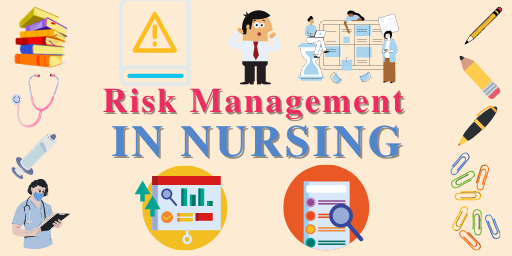Risk Management and Nursing

While quality management is a prevention-oriented
approach, risk management is problem-oriented. It is part of quality
management, but is used to identify, analyze and assess risks and then develop
a plan to reduce the frequency and severity of accidents and injuries. Risk
management is an ongoing daily program of screening, education, and
intervention.
A risk management program involves all departments in the
organization. It must be a company-wide program that must be approved by the
board of directors and contributed by all departments. The program must have
high-level commitment, including the executive director and head nurse. A risk
management program:
1. Identifies potential risks of accident, injury, or
financial loss. Formal and informal communication with all departments in the
organization and facility inspections are essential to identify problem areas.
2. Reviews current organization-wide monitoring systems
(incident reports, audits, committee logs, oral complaints, patient
questionnaires), assesses integrity, and determines additional systems needed
to provide objective data essential for quality control. Risk management.
3. Analyzes the frequency, severity, and causes of the
general categories and specific types of incidents that lead to injury or
adverse patient outcomes. To plan risk intervention strategies, it is necessary
to assess the consequences associated with the different types of incidents.
4. Reviews and evaluates safety and risk aspects of patient care practices and new programs.
5. Oversees laws and codes related to
patient safety, consent, and care.
6. Eliminate or minimize risks.
7. Reviews the work of other committees to identify
potential liabilities and recommend preventive or corrective actions. Examples of
such committees are Infection, Medical Audit, Safety, Pharmacy, Nursing Audit,
and Productivity.
8. Identifies patient, family, and staff training needs
suggested by all of the above and implements the appropriate training program.
9. Evaluate the results of a risk management program. 10.
Provides regular reports to administration, medical staff, and the board of
directors.
The Role of Nursing in Risk Management
In organizational terms, nursing is the only department
involved in patient care around the clock; Therefore, the nursing staff is
critical to the success of a risk management program. The Chief Nursing
Administrator must be committed to the program. Your attitude will influence
employees and their engagement. After all, it is the employees with their daily
contact with the patient who actually implement a risk management program.
An innovative risk reduction program was implemented at a
Midwestern healthcare facility (Kerfoot, Rapala, Ebright & Rogers, 2006).
Led by the risk manager, the purpose of the Safe Path program was to provide a
safe path for patients and a supportive environment for staff. Staff were
selected as Safe Passage Nurses to act as the department's experts in patient
and staff safety, and more importantly, they proactively searched for potential
problem areas. High-risk healthcare areas fall into five general categories:
- Medication errors
- Procedural complications
- Diagnosis or treatment of falls
- Patient or family dissatisfaction with care
- Refusal of treatment or refusal to sign consent form for treatment.
Nursing is involved in all areas, but medical staff may have primary responsibility in cases where treatment is refused or consented to. Medical records and event reports serve to document the responsibility of the organization, the nurse and the doctor. However, for every reported incident, there are more unreported ones. When records are inaccurate, inadequate, or omitted, the organization is more likely to be sued and more likely to lose. Incident reports are used to analyze the severity, frequency and root causes of events within the five risk categories.
Such an analysis
serves as a basis for the intervention.
Incident Reports
Accurate and complete reporting in both the patient record and the incident report is essential to protect the organization and caregivers from litigation. Reporting incidents is usually the responsibility of the caregiver. Reluctance to report incidents is usually due to fear of repercussions.
- This fear can be alleviated through training programs for holding company employees that emphasize factual reporting.
- Refrain from inflammatory words and critical statements.
- Have a clear understanding that the purposes of the incident reporting process are documentation and follow-up; and under no circumstances use the report for disciplinary action.
- Nursing colleagues and care managers should not reprimand another staff member for an incident and never in front of other staff members, patients or patients' family members.
A re-portable incident must include any unexpected or
unplanned event that affects or could potentially affect a patient, family
member or employee. Reporting is only as effective as the form on which it is
reported, so care must be taken to ensure that the form and data required are
appropriate.
Reporting incidents includes the following steps:
1. Nurses, doctors, patients, families, or
any employee or volunteer may report actual or potential risks.
2. Note. The risk manager will receive the completed
incident form within 24 hours of the incident. A phone call can be made in
advance to expedite follow-up in the event of a major incident.
3. Research. The risk manager or officer will promptly
investigate the incident.
4. Advice. The risk manager consults the referring
physician, the risk management committee member, or both for additional
information and guidance.
5. Action. The risk manager should clarify any
misinformation to the patient or their family and explain exactly what
happened. The patient must be referred to the appropriate source of help and,
if necessary, reassured that care for any necessary services will be provided
free of charge.
6. Recording. The risk manager must ensure that all
records, including incident reports, follow-up actions and any actions taken,
are archived in a central repository.




Give your opinion if have any.